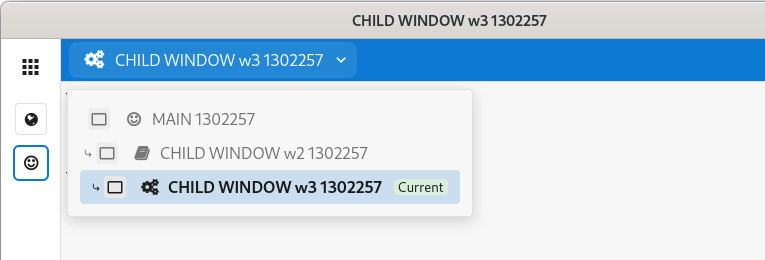Containers for program windows
Program windows are displayed in window containers by the front-end.
Program windows and window container
A Genero program can create multiple windows with the OPEN WINDOW instruction.
- On desktop (GDC), the window container is a frame of the OS window manager.
- In a web browser (GAS), the window container is a browser tab.
- On mobile devices (GMA/GMI), the window container is the device screen.
All windows created by a given program are displayed in the same window container. The window visible to the user will be the current window. If the current window is a modal window, it will appear in a frame on top of the last displayed frame of a normal window.
When multiple programs display their windows/forms in the same window container, on the left of the container, the application list can be used to navigate between these programs.
The chromebar is the top bar with a blue background. It can contain action views (buttons) to trigger actions and system buttons when GBC debug mode is active. By default, the chromebar is not visible when using the GDC desktop front-end, but it can be activated by a GBC theme variable. The chromebar is visible by default when using a browser (GAS) and with mobile devices (GMA/GMI).
To switch between normal windows created by a given program, use the window list, displayed on the top left in the chromebar.
Note that by default, with the GDC front-end, no chromebar is visible: It needs to be enabled with a GBC theme variable (refer to the GBC manual for more details).

Shared or dedicated window containers for programs
With both GDC/desktop and GAS/web browser, when starting a new child program with a
RUN command not using the WITHOUT WAITING clause, the parent
program is frozen and is waiting for the child program to finish. In such case, the child program
windows are always displayed in the same window container.
RUN ... WITHOUT
WAITING will display in the same window container as the parent program. To
force each program to display its windows in a dedicated desktop window container,
define the desktopMultiWindow style attribute to "yes" at the
UserInterface node level:<StyleList>
<Style name="UserInterface">
<StyleAttribute name="desktopMultiWindow" value="yes"/>
</Style>
...
</StyleList>RUN ...
WITHOUT WAITING will display in the same web browser tab as the parent program. To force
each child program to display its windows in a dedicated web browser tab, define the browserMultiPage style attribute to "yes" at the
UserInterface node level:<StyleList>
<Style name="UserInterface">
<StyleAttribute name="browserMultiPage" value="yes"/>
</Style>
...
</StyleList>The application list
The application list shows the set of programs running concurrently and displaying
in the front-end window container, these can be child programs started with RUN
WITHOUT WAITING.

With GAS and a web browser, the browser tabs display titles of regular windows, using the
windowType="normal" (default) style attribute: Titles of windows defines as modal
with windowType="modal" style attribute are not displayed in the browser tab
caption.
<StyleList>
<Style name="UserInterface">
<StyleAttribute name="applicationListVisible" value="no"/>
</Style>
...
</StyleList>The application list can also be shown in the topmenu and in the toolbar of the
current window/form, by using the AUTOCOMMANDS and AUTOITEMS
placeholders, with the CONTENT=PROGRAMS attribute. These placeholders can be
located anywhere in the topmenu and toolbar. For more details, see Automatic action views.
The window list
The window list is defined by the set of windows opened by the current program displayed in the window container.
When the parent application launches multiple child applications and waits for them to complete
(RUN not using WITHOUT WAITING), the window list shows also
windows from those child applications.
The window list can be accessed from the chromebar (no available by default on GDC desktop):

<StyleList>
<Style name="UserInterface">
<StyleAttribute name="windowListVisible" value="no"/>
</Style>
...
</StyleList>The window list can also be shown in the topmenu and in the toolbar of the current
window/form, by using the AUTOCOMMANDS and AUTOITEMS placeholders,
with the CONTENT=WINDOWS attribute. These placeholders can be located anywhere in
the topmenu and toolbar. For more details, see Automatic action views.
RUN command usage and effects
The RUN command can be used to chain
application (program) execution.
In order to handle the application/program chain properly (to display the correct application
list hierarchy), the front-end needs to be aware of the child program execution, before executing
other sub-programs that display GUI. When executing a child program that is interactive, the parent
program must make sure to be connected to the front-end, before executing the RUN
command to start another interactive program.
For example, program A is started and is connected to the front-end. This root
program starts a sub-program B, which does not do any user-interaction, before
starting the third sub-program C, which opens a form and executes a dialog. Since
B did not register to the front-end, it will consider C as if it
was started individually and miss the A->B->C chain.
The solution in such case is to force the intermediate program to connect to the front-end:
MAIN
CALL ui.Interface.refresh()
RUN "fglrun prog-B"
END MAINTabbed containers (deprecated)
tabbedContainer is deprecated and replaced by the new user interface elements to
control application windows. See Containers for program windows for more
details.
tabbedContainer style attribute for the main window of a parent
program:<StyleList>
<Style name="Window.main">
<StyleAttribute name="windowType" value="normal" />
<StyleAttribute name="tabbedContainer" value="yes" />
</Style>
...
</StyleList>When the tabbedContainer style attribute is set to "yes", the
windows of several child programs will be rendered in folder tabs in a parent container.
When using tabbed containers, the tabs created for this rendering becomes the window container of the child programs.
To get tabbed container rendering, the parent program using tabbedContainer must
define a Start Menu.
For reference, see tabbedContainer in the Window style attributes topic.